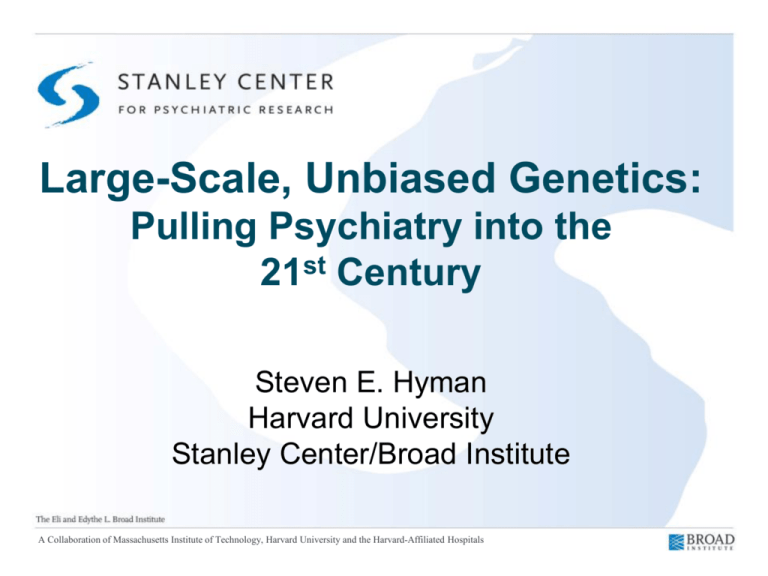
Large-Scale, Unbiased Genetics:
Pulling Psychiatry into the
21st Century
Steven E. Hyman
Harvard University
Stanley Center/Broad Institute
A Collaboration of Massachusetts Institute of Technology, Harvard University and the Harvard-Affiliated Hospitals
Psychiatric Disorders are Common and Disabling
Burden of Diseases, Injuries, and Risk Factors, U.S.1990-2010:
Years lived with disability by age and disease class
Unintentional Injuries
Musculoskeletal
Mental Disorders
:
Source: JAMA 2013 doi:10.1001/jama2013.13805
Date of download: 7/13/2013
Copyright © 2012 American Medical
Association. All rights reserved.
www.broadinstitute.org/psych/stanley
Schizophrenia
Highly heritable brain disease characterized by adolesce
gray matter loss, cognitive impairment, psychosis
Excessive gray matter loss in adolescents with schizophrenia
Source : Vidal et al Arch Gen Psychiatry 2006, 63:25-3
www.broadinstitute.org/psych/stanley
Current drugs for neuropsychiatric disorders
have the same targets as 1950’s prototypes
There are no pharmacologic treatments for the core symptoms
of autism or for the deficit or cognitive symptoms of schizophrenia
www.broadinstitute.org/psych/stanley
Despite high prevalence and vast
unmet need industry has deemphasized psychiatry
• Lack of new molecular targets
• Animal models do not predict efficacy
• Human brain inaccessible to direct study in life
• No validated biomarkers;
descriptive diagnoses
www.broadinstitute.org/psych/stanley
Technology and computation make it
possible to right the research enterprise
Technological revolution of last decade
Genomic and computational technologies
• Stem cell technologies
• Genome engineering technologies
• Tools for systems-level neurobiology
•
New forms of organization for science
Durable consortia for genetic and other large-scale studies
• Large, shared datasets
• Biobanks
• Interdisciplinary collaborative networks
•
www.broadinstitute.org/psych/stanley
High heritabilities mean molecular clues
to pathogenesis lie within our genomes
Heritabilities derived
from twin studies
λ1
heritability
Autism
25
0.65-0.8
Schizophrenia
9
0.8
Bipolar Disorder
8
0.7-0.8
2-5
0.35
Disorder
Major Depression
Source:
Sullivan, Daly, O’Donovan 2012
www.broadinstitute.org/psych/stanley
http://www.broadinstitute.org/psych/stanley
Genetic architecture of psychiatric
disorders
Polygenicity
Hundreds of risk genes and thousands of
alleles to interrogate
Heterogeneity
Diverse genetic paths to illness;
heterogeneous phenotypes (spectra not
categories)
Low Penetrance Alleles
Pleiotropic Effects
Penetrance of individual risk alleles modest.
Even large CNVs have incomplete
penetrance and increase λ by only 10-20x
Shared genetic risk across neuropsychiatric
disorders.
Even large CNVs have variable expressivity
when penetrant
www.broadinstitute.org/psych/stanley
Fecundity of Patients With Schizophrenia, Autism,
BPD, Depression, Anorexia Nervosa, or
Substance Abuse
Ramifications:
Common and low frequency
variants can be plentiful at
very low effect sizes (OR <
1.1)
Transmission of large effect
alleles must be extremely
rare
Fertility ratios for individuals with by disorder and gender.
A fertility ratio of 1 represents that of the general population.
Source: Power et al. JAMA Psychiatry. 2013;70(1):2
Date of download: 3/5/2014
Copyright © 2014 American Medical
Association. All rights reserved.
www.broadinstitute.org/psych/stanley
New technology and global collaboration have
made large-scale, unbiased genetic studies
possible
Samples: robotics,
two-dimensional barcoding
Inexpensive microarrays for
common variants
Sequencing exomes and genomes
for rare variants
www.broadinstitute.org/psych/stanley
Technology makes it possible to address
both common and rare variation at the
needed scale
Inexpensive
microarrays for
ancient
common
variants
Sequencing for
rare variants less
subjected to
natural selection
Ancient variation that is
common across populations
www.broadinstitute.org/psych/stanley
Genome-wide common variant
association in schizophrenia in 2009
(4,000 cases)
“
www.broadinstitute.org/psych/stanley
Relationship of sample size to genomewide significant findings
www.broadinstitute.org/psych/stanley
Genome-wide common variant
association in schizophrenia in 2011
(10,000 cases)
www.broadinstitute.org/psych/stanley
PGC schizophrenia Common Variant
Association; 37,000 cases
ORs average approximately 1.08
www.broadinstitute.org/psych/stanley
Global Collaborations are Required for
Effective Sample Collection
www.broadinstitute.org/psych/stanley
Sequencing to find rare, protein-altering
alleles
Trio studies
Sequencing to find new, protein-altering mutations in
father-mother-proband autism and schizophrenia trios
cases
controls
Case-control studies
Sequencing to find genes for which rare, proteindamaging mutations are more common in cases
than controls
www.broadinstitute.org/psych/stanley
Rare Variant Association
Human exomes are teeming
with variation:
It is easy to find rare variants, but
hard to establish disease associations
~20,000 variants in or near
protein coding genes.
~200 are missense
~100 are loss-of-function
(deletions, single-nucleotide
variants) of which ~20 are
very rare or private
Plan: Sequencing “surge”
across diverse human
populatons
www.broadinstitute.org/psych/stanley
Genetics update
Datasets coming on board (estimates)
Schizophrenia
Year
GWAS
Exome Seq
Genome Seq
2015
~60K cases
6K cases
1K cases
2016-2017
~80K cases
20K cases
5K cases
2018-2019
>100K cases
Year
GWAS
Exome Seq
Genome Seq
2015
~18K cases
6K cases
None
2016-2017
~20K cases
15K cases
500 cases
2018-2019
~22K cases
20K cases
~1K cases
40K cases
Autism
10K cases
Note: Balance between exome and whole genome sequencing will be influenced by c
19| SC – NVS JSC Informatics workstream | February 19, 2015 | Business Use Only
www.broadinstitute.org/psych/stanley
Epilepsy: ILAE Consortium Meta-Analysis
2014
Source: Lancet Neurology 2014
www.broadinstitute.org/psych/stanley
Why do we care about alleles of small effect?
They are our best tools to glean biological
clues
Risk alleles identify
disease-relevant genes
Genes identify pathways
and protein networks
These illuminate disease
mechanisms and suggest
drug targets
Statins
act on
HMG CoA-reductase
www.broadinstitute.org/psych/stanley
An initial ‘parts list’ for schizophrenia
Voltage-gated calcium channels
CACNA1C
CACNA1D
CACNA1I
CACNB2
CACNB3
Selective protein degradation
KCTD13
UBE3A
Cytoskeleton and
synapse assembly
GIT1
SYNGAP1
ITSN1
Glutamate/NMDA signaling
GRIA1
GRIN2A
GRIN2B
GRM3
NRGN
Immune system related proteins
Complement components
www.broadinstitute.org/psych/stanley
We need good high throughput,
evolutionarily appropriate living
systems
Poor access to human
brain tissue in life
Rodent models poor for
•
•
•
Dividing human cancer
cell from excision
High throughput studies
Studying noncoding
sequences:
poorly conserved compared
with exons
Modeling diseases that
affect evolutionarily recent
cell types and circuits
www.broadinstitute.org/psych/stanley
Stem cell technology enables high
throughput systems expressing human
transcriptional networks
Differentiate
iPSCs
phenotype
hESCs
Build circuits
CRISPR: add risk variants
or rescue patient cells
Small molecule
Screens
Compare genetic rescue
to small molecule effects
www.broadinstitute.org/psych/stanley
Search for translatable phenotypes
90 myr
40 myr
www.broadinstitute.org/psych/stanley
The human model for the human
Assuming that toxicity has been tested in animals, can we
take a central nervous system (CNS) drug into humans
that has only been tested in cellular models?
The issues are both ethical and pragmatic (will companies
invest without animal ‘efficacy gate’?)
www.broadinstitute.org/psych/stanley
An entire community has come together
around these efforts
Broad Institute, Harvard, & MIT
Genetics
Stem Cells
Steve McCarroll
Kevin Eggan
Mark Daly
Paola Arlotta
Ben Neale
Lee Rubin
Aarno Palotie
Karestan Koenen
Therapeutics and Clinical Trials
Elise Robinson
Ed Scolnick
Shaun Purcell
Ed Holson
Stephan Ripke
Roy Perlis
Giulio Genovese
Maurizio Fava
Jennifer Moran
Yan-ling Zhang
Jon Madison
Neurobiology
Guoping Feng
Proteomics
Jen Pan
Wade Harper
Bernardo Sabatini
Kasper Laage
Zhanyan Fu
Genome Engineering
Feng Zhang
Neuroimmunology
Beth Stevens
Karolinska Institute
Christina Hultman
Mikael Landen
Anna Kahler
iPsych Denmark
Bo Preben Mortensen
Cardiff University
Michael O’Donovan
Michael Owen
George Kirov
Nick Craddock
Mt. Sinai College of Medicine
Pamela Sklar
Johns Hopkins
Rick Huganir
Akira Sawa
Novartis Institute for
Biomedical Research
Ricardo Dolmetsch
UNC-Chapel Hill
Patrick Sullivan
USC
Carlos Pato
Michele Pato
Jim Knowles
University of Capetown
Dan Stein
Mexico City
Maria Elena Medina Mora
New Collaborations
Japan
Finland
Funding
Stanley Medical Research Institut
Kent and Liz Dauten
NIH (NHGRI, NIMH)
www.broadinstitute.org/psych/stanley







